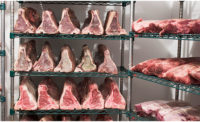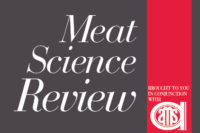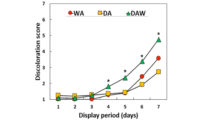Meat Science Review
Meat Science Review: Enhancing the beef round for retail display

Appearance of retail beef cuts is a major influencer of consumer purchasing decisions. High oxygen modified atmosphere packaging (HiOx-MAP) is a tool that can be used to improve bright red color; however, prolonged storage in this type of packaging may lead to increased oxidation, discoloration, undesirable flavor and potential loss of tenderness.
Addition of calcium may be one way to increase tenderness because calcium activates calpain enzymes in the muscle that degrade structural proteins. Early experiments in this area used calcium chloride, which unfortunately led to meat discoloration. One alternative is the use of calcium lactate along with another antioxidant such as phosphate. The combination of calcium lactate plus sodium phosphate could potentially reduce the oxidative effects of HiOx-MAP and improve color stability while concurrently increasing tenderness.
We decided to test this hypothesis in low-value beef cuts from the round in order to determine whether calcium lactate enhancement could be a way to add market appeal. We used semitendinosus (eye of round) and semimembranosus (top round) steaks from feedlot steers. The semimembranosus steaks were divided into inside and outside portions to account for the large size of the muscle and any chilling-related effects.
Steaks (24 hours postmortem) were assigned to three treatments (water-injected control, sodium tripolyphosphate only, and calcium lactate plus sodium tripolyphosphate). The steaks were stored nine days in vacuum bags followed by seven days under HiOx-MAP or vacuum conditions.
Calcium lactate plus phosphate substantially reduced lipid oxidation of semitendinosus and semimembranosus steaks by as much as 73 percent compared with water-injected controls. Phosphate enhanced steaks were intermediate in lipid oxidation. Less oxidation can result in longer shelf life and consumer acceptability.
Steaks treated with phosphate or calcium lactate plus phosphate were lighter in color than water-injected controls. Seven days of HiOx-MAP storage reduced redness compared with vacuum packaging in semimembranosus but not semitendinosus steaks. Treatment with phosphate or calcium lactate plus sodium phosphate did not have an effect on redness in the HiOx-MAP semimembranosus, but decreased redness in the semitendinosus. All values, however, were still in an acceptable color range.
Like other research, HiOx-MAP steaks in this study had decreased tenderness compared with their vacuum-packaged counterparts. Enhancement with calcium lactate plus phosphate or phosphate alone did not affect tenderness in the semitendinosus (eye of round) but improved tenderness in the semimembranosus (top round). Similarly, HiOx-MAP semitendinosus and inside semimembranosus steaks were less juicy. Enhancement did not improve juiciness. Lack of improvement in sensory characteristics of the semitendinosus may have been due to the high amount of insoluble connective tissue of this muscle.
These results indicate that injection of calcium lactate in conjunction with phosphate may improve overall sensory tenderness in some muscles from the beef round. In addition, oxidation during display in HiOx-MAP may be slowed by the addition of calcium lactate in conjunction with phosphate, increasing the amount of time retail cuts can be displayed.
Information sourced from: Cruzen SM, Kim YHB, Lonergan SM, Grubbs JK, Fritchen AN, Huff-Lonergan E. Effect of early postmortem enhancement of calcium lactate/phosphate on quality attributes of beef round muscles under different packaging systems. Meat Sci. 2015;101:63-72.
Looking for a reprint of this article?
From high-res PDFs to custom plaques, order your copy today!





